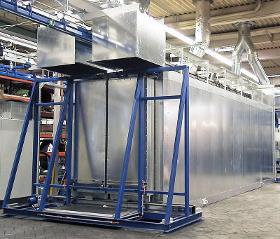- europages
- >
- COMPANIES - SUPPLIERS - SERVICE PROVIDERS
- >
- high temperature furnace
Results for
High temperature furnace - Import export

RIPPERT ANLAGENTECHNIK GMBH & CO. KG
Germany
For temperatures up to 450 °C. High-temperature furnaces Tempering furnace for car chassis stabilisers Previously cold-formed workpieces, e.g. stabilisers, are heated up in the tempering furnace at circulating air temperatures of up to 450°C and maintained at this temperature for an adjustable dwell time. This tempering increases toughness and dissipates residual stresses. Preheating furnace for frying pans and roasting tins Pan blanks are heated up to a temperature of approx. 390 °C and burnt free of all grease and oil residues. Enamelling furnace for frying pans and roasting tins The PTFE coating sprayed beforehand onto the frying pans is baked on at a temperature of approx. 450 °C. PTFE is used as a non-stick coating for frying pans and cooking pots on account of its low surface tension and good heat resistance. Chamber enamelling furnace for aluminium sheet metal forms Baking on of the single or multi-layer PTFE coatings at approx. 450 °C.
Request for a quote
EWG E. WAGENER GMBH
Germany
Tantalum is a shiny grey, very hard and yet ductile heavy metal from the vanadium group, it is easy to form and weld. Tantalum belongs to the refractory metals, is very resistant to almost all acids (except hydrofluoric acid) and has a high absorption capacity for hydrogen and nitrogen. In nature, tantalum only occurs bound together with niobium. Tantalum is used in electrical engineering, chemistry, in high-temperature furnace construction, in evaporation plants and even in nuclear technology. Tantalum is added as an alloying component to rust and acid-resistant steels. Tantalum carbide is used for the production of hard metals. At E.WAGENER you can obtain tantalum in all common forms, alloys and processing forms, always in accordance with your requirements.
Request for a quote
EWG E. WAGENER GMBH
Germany
Tungsten is a silver-white, metallically shiny or grey heavy metal (depending on whether it occurs in pieces or in powder form). Hard and brittle, tungsten can, however, be made ductile by hammering and drawn into thin wires, for example. Tungsten belongs to the group of refractory metals, which are characterized by high melting points, good thermal conductivity and low thermal expansion, among other things. High corrosion resistance is a further characteristic. Tungsten is suitable for the construction of resistance heating elements, the manufacture of filaments (especially in high-temperature furnace construction and electrical engineering), engine parts, X-ray anodes and welding electrodes. Pins made of tungsten can be fused into high melting point glass for the passage of current. Tungsten is also used in nuclear technology. Tungsten alloys are used about 80% in the steel industry and about 10% each in the hard metal and electrical industries.
Request for a quote
UNITED PROCESS CONTROLS GMBH
Germany
The Oxyfire™ in-situ oxygen sensor measures oxygen concentrations directly in the "high heat" zones of high temperature furnaces, boilers and incinerators. They are intrinsically safe, requiring no electrical input power, and generating only a low millivolt output. FEATURES • Available in a number of standard lengths up to 48" (1200 mm) • Field performance can be easily verified using integral verification gas port • Intrinsically Safe per EN50 014 (1977) clause 1.3 • Temperature Range: 1000°F (min) to 3000°F (max) / 538°C (min) to 1649°C (max) • Robust design eliminates "auxiliary sheaths" required on lower quality products • Single side connections ensure cables are safely away from the hot furnace wall • Proven track record: used in more furnaces, boilers and incinerators than all other high-temp probes combined • No drift or accuracy problems common to "side hole" probes • High quality construction eliminates the need for cooling air • Proprietary installation configuration...
Request for a quote
CBG COMPOSITES GMBH
Germany
High-temperature vacuum-formed products made from biosoluble ceramic fibres are lightweight and solid parts or structural elements that can be used at temperatures up to 1.400 °C in air and in aggressive environments, including direct contact with liquid metals. — 100% biosoluble — high temperature resistance — low thermal conductivity — high chemical resistance * — low weight — good tear resistance — high flexibility — easy processing — complicated geometries can be produced — recyclable * to achieve higher acid resistance, a special coating is required. Available from manufacturer. Application: Burner plant components, crucibles, thermocouple housings, coupling devices in continuous casting plants, channel elements of metal troughs, inlet device in the melting of non-ferrous and ferrous metals, gasket in aluminium foundries, gaskets in blast furnaces, expansion joints, pipe insulation, catalyst insulation, repair work in the high temperature range.
Request for a quote
CBG COMPOSITES GMBH
Germany
High-temperature vacuum-formed products made from biosoluble ceramic fibres are lightweight and strong parts or structural elements that can be used at temperatures up to 1 .600 °C in air and in aggressive environments, including direct contact with liquid metals. — 100% natural — biosoluble — high thermal shock resistance — low thermal conductivity — high chemical resistance * — recyclable — low weight — good tear resistance — high flexibility — easy processing — harmless to health — complicated geometries can be produced * A special coating is required to achieve high acid resistance. Available from manufacturer. Fields of application: gaskets, crucibles, thermocouple housings, coupling devices in continuous casting plants, expansion joints, convex and flat gaskets in blast furnaces, channel elements of metal troughs, inlet device in the melting of non-ferrous and ferrous metals.
Request for a quoteDo you sell or make similar products?
Sign up to europages and have your products listed
Results for
High temperature furnace - Import exportNumber of results
6 ProductsCountries
Company type
Category